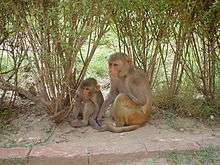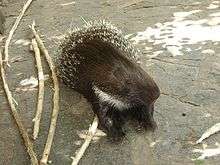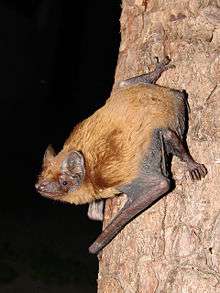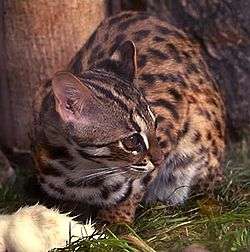List of mammals of Macau
This is a list of the mammal species recorded in Macau. There are 83 mammal species in Macau.[1]
The following tags are used to highlight each species' conservation status as assessed by the International Union for Conservation of Nature:
| LC | Least concern | There are no current identifiable risks to the species. |
Some species were assessed using an earlier set of criteria. Species assessed using this system have the following instead of near threatened and least concern categories:
| LR/cd | Lower risk/conservation dependent | Species which were the focus of conservation programmes and may have moved into a higher risk category if that programme was discontinued. |
| LR/nt | Lower risk/near threatened | Species which are close to being classified as vulnerable but are not the subject of conservation programmes. |
| LR/lc | Lower risk/least concern | Species for which there are no identifiable risks. |
Subclass: Theria
Infraclass: Eutheria
Order: Sirenia (manatees and dugongs)
Sirenia is an order of fully aquatic, herbivorous mammals that inhabit rivers, estuaries, coastal marine waters, swamps, and marine wetlands. All four species are endangered.
- Family: Dugongidae
- Genus: Dugong
- Dugong, Dugong dugon VU possibly extirpated from local waters, very small numbers in Hainan Province, Leizhou Peninsula and Gulf of Tonkin; unknown in other areas along Fujian Province
- Genus: Dugong
Order: Primates
The order Primates contains humans and their closest relatives: lemurs, lorisoids, monkeys, and apes.
- Suborder: Haplorhini
- Infraorder: Simiiformes
- Parvorder: Catarrhini
- Superfamily: Cercopithecoidea
- Family: Cercopithecidae (Old World monkeys)
- Genus: Macaca
- Rhesus macaque, Macaca mulatta LR/nt
- Crab-eating macaque, Macaca fascicularis
- Tibetan macaque, Macaca thibetana only hybrids left
- Genus: Macaca
- Family: Cercopithecidae (Old World monkeys)
- Superfamily: Cercopithecoidea
- Parvorder: Catarrhini
- Infraorder: Simiiformes
Order: Soricomorpha (shrews, moles, and solenodons)
The "shrew-forms" are insectivorous mammals. The shrews and solenodons closely resemble mice while the moles are stout-bodied burrowers.
- Family: Soricidae (shrews)
- Subfamily: Crocidurinae
- Genus: Crocidura
- Southeast Asian shrew, Crocidura fuliginosa unconfirmed
- Asian gray shrew, Crocidura attenuata unconfirmed
- Must shrew, Suncus murinus
- Genus: Crocidura
- Subfamily: Crocidurinae
Order: Rodentia (mice, squirrels, etc)
The order Rodentia is a large group of mammals. They have two incisors in the upper as well as in the lower jaw which grow continuously and must be kept worn down by gnawing.
- Muridae
- Subfamily: Murinae
- Genus: Bandicota
- Greater bandicoot rat, Bandicota bengalensis
- Chestnut spiny rat, Niviventer fulvescens
- House mouse, Mus musculus
- Brown rat, Rattus norvegicus
- Ryukyu mouse, Mus caroli
- Sikkim rat, Rattus andamanensis
- Asiatic house rat, Rattus tanezumi
- Roof rat, Rattus rattus
- Genus: Bandicota
- Subfamily: Murinae
- Family: Sciuridae
- Pallas's squirrel, Callosciurus erythraeus introduced
- Indian giant flying squirrel, Petaurista philippensis
- Family: Hystricidae (porcupines)
- Genus: Hystrix
- Malayan porcupine, Hystrix brachyura
- Genus: Hystrix
Order: Chiroptera (bats)
The bats' most distinguishing feature is that their forelimbs are developed as wings, making them the only mammals capable of flight. Bat species account for about 50% of all mammals.
- Family: Pteropodidae
- Genus: Rousettus
- Leschenault's rousette, Rousettus leschenaultia
- Genus: Cynopterus
- Greater short-nosed fruit bat, Cynopterus sphinx
- Genus: Rousettus
- Family: Emballonuridae
- Genus: Taphozous
- Black-bearded tomb bat, Taphozous melanopogon
- Genus: Taphozous
- Family: Rhinolophidae
- Genus: Rhinolophus
- Rufous horseshoe bat, Rhinolophus rouxi common
- Intermediate horseshoe bat, Rhinolophus affinus common
- Least horseshoe bat, Rhinolophus pusillus common
- Genus: Rhinolophus
- Family: Hipposideridae
- Genus: Hipposideros
- Pomona roundleaf bat, Hipposideros pomona common
- Himalayan roundleaf bat, Hipposideros armiger LC
- Genus: Hipposideros
- Family: Vespertilionidae
- Genus: Myotis
- Large myotis, Myotis chinensis LR/lc
- Rickett's big-footed bat, Myotis ricketti LR/lc
- Fringed long-footed myotis, Myotis fimbriatus LR/nt No ??? LC
- Horsfield's bat, Myotis horsfieldii LC rare in the region
- Daubenton's bat, Myotis daubentonii rare
- Genus: Pipistrellus
- Japanese pipistrelle, Pipistrellus abramus
- Chinese pipistrelle, Pipistrellus pulveratus rare
- Genus: Nyctalus
- Common noctule, Nyctalus noctula LR/lc LC
- Genus: Tylonycteris
- Lesser bamboo bat, Tylonycteris pachypus LC rare in the region
- Greater bamboo bat, Tylonycteris robustula
- Genus: Scotophilus
- Lesser yellow bat, Scotophilus kuhlii rare
- Genus: Miniopterus
- Western bent-winged bat, Miniopterus magnater LC common
- Common bent-wing bat, Miniopterus schreibersii CD rare
- Small bent-winged bat, Miniopterus pusillus
- Genus: Myotis
- Family: Molossidae
- Genus: Chaerephon
- Wrinkle-lipped free-tailed bat, Chaerephon plicata
- Genus: Chaerephon
Order: Pholidota (pangolins)

The order Pholidota comprises the eight species of pangolin. Pangolins are anteaters and have the powerful claws, elongated snout and long tongue seen in the other unrelated anteater species.
- Family: Manidae
- Genus: Manis
- Chinese pangolin, Manis pentadactyla LR/nt
- Genus: Manis
Order: Cetacea (whales)
The order Cetacea includes whales, dolphins and porpoises. They are the mammals most fully adapted to aquatic life with a spindle-shaped nearly hairless body, protected by a thick layer of blubber, and forelimbs and tail modified to provide propulsion underwater.
- Suborder: Mysticeti
- Family: Balaenidae
- Genus: Eubalaena
- North Pacific right whale, Eubalaena japonica CR possibly seen historically
- Genus: Eubalaena
- Family: Eschrichtiidae
- Genus: Eschrichtius
- Western gray whale, Eschrichtius robustus CR historically seen
- Genus: Eschrichtius
- Family: Balaenopteridae
- Subfamily: Megapterinae
- Genus: Megaptera
- Humpback whale, Megaptera novaeangliae VU very rare today
- Genus: Megaptera
- Subfamily: Balaenopterinae
- Genus: Balaenoptera
- Common minke whale, Balaenoptera acutorostrata LC unconfirmed
- Omura's whale, Balaenoptera omurai DD possibly in Hong Kong[2] and neighboring countries
- Bryde's whale, Balaenoptera brydei DD
- Eden's whale, Balaenoptera edeni EN
- Fin whale, Balaenoptera physalus EN unconfirmed
- Genus: Balaenoptera
- Subfamily: Megapterinae
- Family: Balaenidae
- Suborder: Odontoceti
- Superfamily: Platanistoidea
- Genus: Physeter
- Family: Physeteridae
- Sperm whale, Physeter macrocephalus
- Family: Physeteridae
- Family: Kogiidae
- Genus: Kogia
- Pygmy sperm whale, Kogia breviceps DD
- Dwarf sperm whale, Kogia sima DD
- Genus: Kogia
- Family: Delphinidae (marine dolphins)
- Family: Phocoenidae
- Genus: Neophocaena
- Finless porpoise, Neophocaena phocaenoides phocaenoides DD
- Sunameri, Neophocaena phocaenoides sunameri DD
- Genus: Sousa
- Chinese white dolphin, Sousa chinensis NT local population is critically endangered
- Genus: Tursiops
- Indo-Pacific bottlenose dolphin, Tursiops aduncus DD
- Common bottlenose dolphin, Tursiops truncatus DD
- Genus: Delphinus
- Long-beaked common dolphin, Delphinus capensis DD
- Genus: Stenella
- Pantropical spotted dolphin, Stenella attenuata LR/cd
- Spinner dolphin, Stenella longirostris DD
- Striped dolphin, Stenella coeruleoalba LR/cd
- Genus: Steno
- Rough-toothed dolphin, Steno bredanensis LC
- Genus: Lagenodelphis
- Fraser's dolphin, Lagenodelphis hosei DD
- Genus: Grampus
- Risso's dolphin, Grampus griseus LC
- Genus: Pseudorca
- False killer whale, Pseudorca crassidens EN
- Genus: Neophocaena
- Genus: Physeter
- Superfamily: Platanistoidea
Order: Artiodactyla (herbivores)
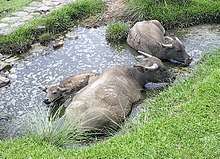
The order Artiodactyla in Macau are mainly herbivore which feed only on plant material, except wild boar. There are three types of herbivores (includes native and feral) in recent Hong Kong.
Order: Carnivora (carnivorans)
There are over 260 species of carnivorans, the majority of which eat meat as their primary dietary item. They have a characteristic skull shape and dentition.
- Suborder: Feliformia
- Family: Felidae (cats)
- Subfamily: Felinae
- Genus: Prionailurus
- Leopard cat, Prionailurus bengalensis LC
- Feral cat, Felis catus
- Genus: Prionailurus
- Subfamily: Pantherinae
- Genus: Panthera
- Leopard, Panthera pardus
- South China tiger, Panthera tigris amoyensis
- Genus: Panthera
- Subfamily: Felinae
- Family: Canidae (dogs, wolves, etc.)
- Family: Viverridae (civets, etc.)
- Subfamily: Viverrinae
- Genus: Viverricula
- Small Indian civet, Viverricula indica LR/lc
- Large Indian civet, Viverra zibetha
- Masked palm civet, Paguma larvata taivana
- Genus: Viverricula
- Subfamily: Viverrinae
- Family: Herpestidae (mongoose)
- Subfamily: Herpestinae
- Genus: Herpestes
- Small Asian mongoose, Herpestes javanicus
- Crab-eating mongoose, Herpestes urva
- Genus: Herpestes
- Subfamily: Herpestinae
- Family: Felidae (cats)
- Suborder: Caniformia
- Family: Mustelidae (mustelids)
- Genus: Mustela
- Yellow-bellied weasel, Mustela kathiah
- Genus: Martes
- Yellow-throated marten, Martes flavigula
- Genus: Lutra
- European otter, Lutra lutra NT
- Genus: Melogale
- Chinese ferret badger, Melogale moschata
- Genus: Mustela
- Family: Mustelidae (mustelids)
Notes
- This list is derived from the IUCN Red List which lists species of mammals and includes those mammals that have recently been classified as extinct (since 1500 AD). The taxonomy and naming of the individual species is based on those used in existing Wikipedia articles as of 21 May 2007 and supplemented by the common names and taxonomy from the IUCN, Smithsonian Institution, or University of Michigan where no Wikipedia article was available.
- http://www.hkpost.com.hk/index2.php?id=8607#.Vtkq2vBf3Mr
References
- "The IUCN Red List of Threatened Species: Mammals of Macau". IUCN. 2001. Retrieved 22 May 2007.
- "Mammal Species of the World". Smithsonian National Museum of Natural History. 2005. Archived from the original on 27 April 2007. Retrieved 22 May 2007.
- "Animal Diversity Web". University of Michigan Museum of Zoology. 1995–2006. Retrieved 22 May 2007.

